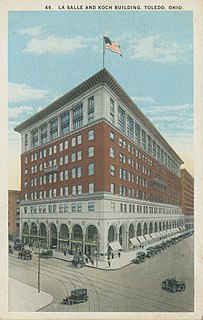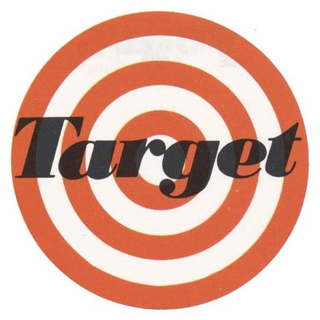
Macy's is an American chain of high-end department stores founded in 1858 by Rowland Hussey Macy. It became a division of the Cincinnati-based Federated Department Stores in 1994, through which it is affiliated with the Bloomingdale's department store chain; the holding company was renamed Macy's, Inc. in 2007. As of 2015, Macy's was the largest U.S. department store company by retail sales.
Marshall Field & Company was an upscale department store in Chicago, Illinois. Founded in the 19th century, it grew to become a large chain before Macy's, Inc acquired it in 2005. Its eponymous founder, Marshall Field, was a pioneering retail magnate.
Dayton's was an American department store chain founded in Minneapolis, Minnesota, in 1902 by George Draper Dayton. It operated several local high end department stores throughout Minnesota and the Upper Midwest for almost 100 years. Although it was regionally known as a high-quality shopping destination, Dayton's is best remembered for starting the discount shopping chain Target. The company was also instrumental in the history of shopping malls; opening the first indoor shopping mall in the United States, Southdale Center in Edina, Minnesota, in 1956.
Jordan Marsh was an American department store chain that was headquartered in Boston, Massachusetts, and operated throughout New England. It was founded by Eben Dyer Jordan and Benjamin L. Marsh in 1841. The ownership of Jordan Marsh was transferred between several holding companies during its operation, including Hahn Department Stores in 1928, Allied Stores in 1935, and Federated Department Stores in 1988. The brand was retired and most stores were converted into the New York City-based Macy's in 1996.
Woodward & Lothrop was a department store chain headquartered in Washington, D.C. that began as the capital's first department store in 1887. Woodies, as it was often nicknamed, maintained stores in the Mid-Atlantic United States. Its flagship store was a fixture of Washington, D.C.'s downtown shopping district, competing with Garfinckel's and acquiring Palais Royal. The chain filed for bankruptcy in January 1994 and completed liquidation in November 1995, with most locations sold to either J. C. Penney or May Department Stores Company. The flagship building is a D.C. historic landmark that would become the center of controversy over competing visions for DC's urban renewal after the chain's demise, and the former service warehouse in the city's northeast is also listed as a landmark.
L. S. Ayres and Company was a department store based in Indianapolis, Indiana, and founded in 1872 by Lyman S. Ayres. Over the years its Indianapolis flagship store, which opened in 1905 and was later enlarged, became known for its women's fashions, the Tea Room, holiday events and displays, and the basement budget store. As urban populations shifted to the suburbs, Ayres established branch stores in new shopping centers in several Indiana cities. Ayres also acquired retail subsidiaries in Springfield, Illinois; Fort Wayne, Indiana; and Louisville, Kentucky. Ayr-Way, the Ayres discount store subsidiary, became the first discount store launched by a full-line department store. By the end of the 1960s Ayres had become a diversified merchandising business with retail department stores, a chain of discount stores, specialty clothing stores, a home furnishings showroom, and a real estate holding company. A long-time Ayres slogan, "That Ayres Look", promoted the company as a fashion leader, and by 1972 it had become the oldest continuous retail slogan in the United States.

Meier & Frank was a prominent chain of department stores founded in Portland, Oregon, and later bought by The May Department Stores Company. Meier & Frank operated in the Pacific Northwest from 1857 to 2006.

Somerset Collection is a superregional, luxury shopping mall, located in Metro Detroit, in Troy, Michigan with more than 180 specialty stores. Somerset Collection, developed, managed, and co-owned by The Forbes Company, is among the most profitable malls in the United States not owned by a real estate investment trust. Out of the 100 most profitable malls, 76 are owned by real estate investment trusts.

B. Dalton Bookseller was an American retail bookstore chain founded in 1966 by Bruce Dayton, a member of the same family that operated the Dayton's department store chain. B. Dalton expanded to become the largest retailer of hardcover books in the United States, with 798 stores at the peak of the chain's success. Located primarily at indoor shopping malls, B. Dalton competed primarily with Waldenbooks. Barnes & Noble acquired the chain from Dayton's in 1987 and continued to operate it until a late 2009 announcement that the last 50 stores would be liquidated by January 2010. B. Dalton was later revived by rebranding a Barnes & Noble location in 2022.
Apache Mall is the largest enclosed shopping mall in Rochester, Minnesota. It was built in 1969 at the intersection of U.S. Route 52 and U.S. Route 14. The Mall's food court has had free Wi-Fi access provided by Charter Communications since January 2007. Apache Mall is owned and managed by Brookfield Properties, who acquired General Growth Properties in 2018. The mall's anchor stores are Scheels All Sports, Barnes & Noble, Macy's, and JCPenney. Boston Shoe & Boot Repair, Orangetheory Fitness, and Men's Wearhouse are junior anchors. There is 1 vacant anchor store that was once Herberger's. In 2014, the mall's Sears store was closed. However, shortly after the Sears was shut down, plans for a Scheels All Sports were announced, as well as an expansion of the building. Scheels opened in 2015. On April 18, 2018, it was announced that Herberger's would be closing as parent company The Bon-Ton Stores was going out of business. The store closed on August 29, 2018.

Northland Center was a shopping mall on an approximately 159-acre (64 ha) site located near the intersection of M-10 and Greenfield Road in Southfield, Michigan, an inner-ring suburb of Detroit, Michigan, United States. Construction began in 1952 and the mall opened on March 22, 1954. Northland was a milestone for regional shopping centers in the United States. Designed by Victor Gruen, the mall initially included a four-level Hudson's with a ring of stores surrounding it. As originally built, it was an open air pedestrian mall with arrayed structures. The mall was enclosed in 1975 and expanded several times in its history. Additions included five other department store anchors: J. C. Penney in 1975, MainStreet in 1985, and TJ Maxx, Target, and Montgomery Ward in the 1990s. Managed by Spinoso Real Estate Group, Northland Center featured approximately 100 stores. Macy's, the last anchor, closed on March 22, 2015, exactly 61 years to the date of the mall's opening.

The J. L. Hudson Building ("Hudson's") was a department store located at 1206 Woodward Avenue in downtown Detroit, Michigan. It was constructed beginning in 1911, with additions throughout the years, before being "completed" in 1946, and named after the company's founder, Joseph Lowthian Hudson. Hudson's first building on the site opened in 1891 but was demolished in 1923 for a new structure.It was the flagship store for the Hudson's chain. The building was demolished in a controlled demolition on October 24, 1998, and at the time it was the tallest building ever imploded.
Crowley Milner and Company, generally referred to as Crowley's, was a department store chain founded in Detroit, Michigan, in 1909. After several years of financial difficulties, the company ceased operation in 1999 and its assets were sold.

Westland Shopping Center, also known as Westland Center, is an enclosed shopping mall located in the city of Westland, Michigan, a suburb of Detroit. The mall features more than 100 inline stores, with JCPenney and Kohl's serving as anchor stores.

Southland Center is an enclosed mall located at 23000 Eureka Road in Taylor, Michigan, exactly halfway between U.S. Highway 24 and the Interstate 75 freeway. The anchor stores are Cinemark Theatres, Forever 21, Best Buy, Shoe Carnival, JCPenney, and Macy's. Other major stores include H&M and Ulta Beauty. It is the newest of the Detroit area's four "land" malls. Southland Center opened on July 20, 1970. It is owned and managed by Brookfield Properties, one of the largest mall owners in the United States.

The Lower Woodward Avenue Historic District, also known as Merchant's Row, is a mixed-use retail, commercial, and residential district in downtown Detroit, Michigan, located between Campus Martius Park and Grand Circus Park Historic District at 1201 through 1449 Woodward Avenue and 1400 through 1456 Woodward Avenue. The district was listed on the National Register of Historic Places in 1999.

Lasalle & Koch Co. or Lasalle's was a department store in Toledo, Ohio, with branches in some nearby communities.

The history of Target Corporation first began in 1902 by George Dayton. The company was originally named Goodfellow Dry Goods in June 1902 before being renamed the Dayton's Dry Goods Company in 1903 and later the Dayton Company in 1910. The first Target store opened in Roseville, Minnesota in 1962 while the parent company was renamed the Dayton Corporation in 1967. It became the Dayton-Hudson Corporation after merging with the J.L. Hudson Company in 1969 and held ownership of several department store chains including Dayton's, Hudson's, Marshall Field's, and Mervyn's. In 2000, the Dayton-Hudson Corporation was renamed to Target Corporation.
Department stores are an established retail format globally. The format has origins in France, the United Kingdom and United States, among many others.











